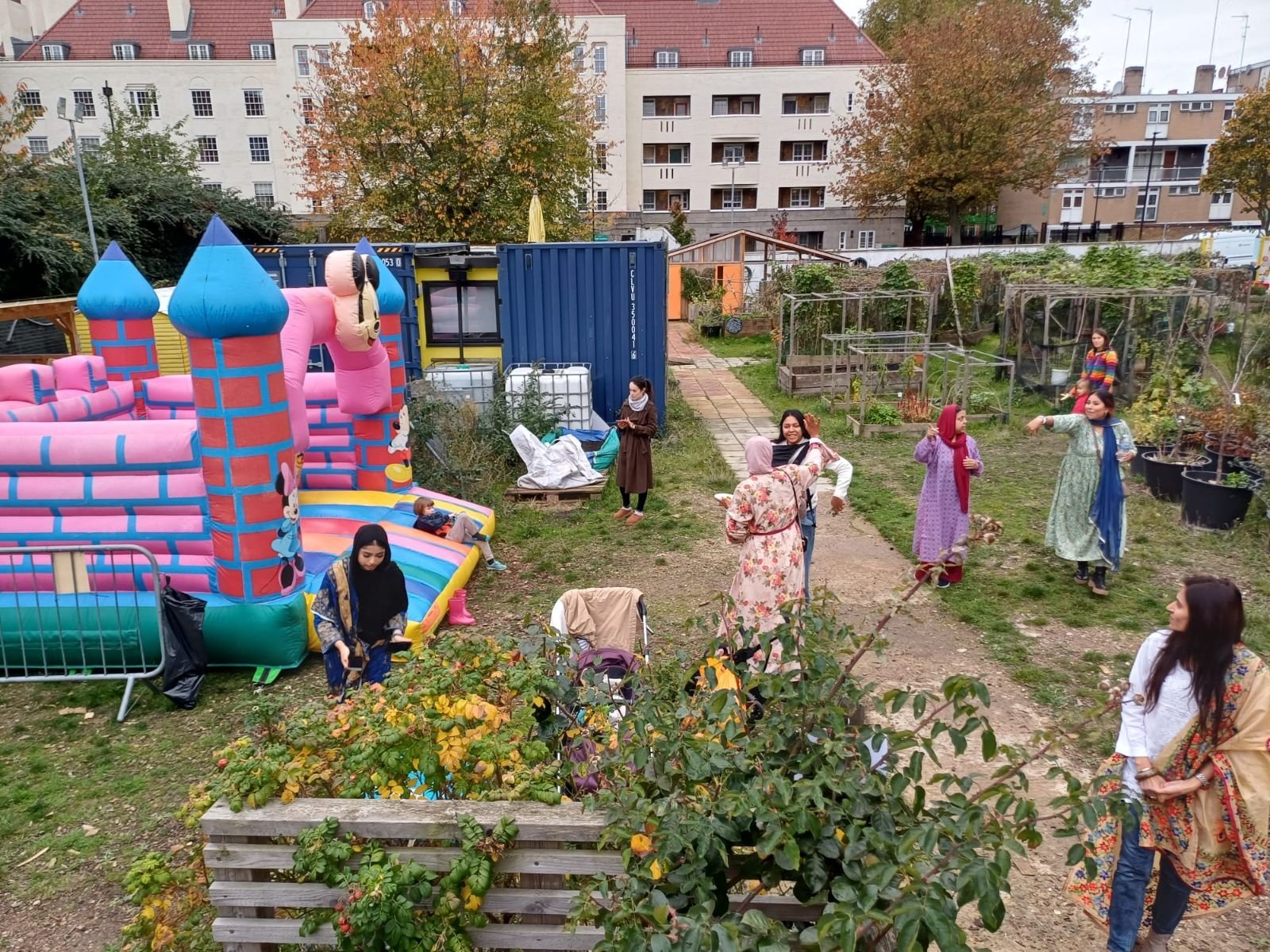Learnings from Future Neighbourhoods
It’s a beautifully golden afternoon in late October, and I am sitting in Somers Town on a table outside the pub, admiring the seven foot sunflowers that are growing opposite the medical centre. I’ve just come off the train from out of town into frantic Kings Cross, and at first I panicked a little bit, knowing that the story garden is closed for the evening - where can I wait that is not this frantic, and that is not indoors, in the dark pub… but then I found this seat in somers town with the sunflowers…and I settled down.
It’s the perfect spot to reflect on my future neighbourhoods research questions, which are:
What happens when we put gardens on people’s estates, rather than invite people into our space? What are the different gifts that come from working outside of the garden in this way, and what are the different challenges?
Working closely with Joy (Community outreach coordinator) and Sharin (Community outreach manager) over the last few months, I've noticed the importance that they both place on listening to the residents, as Joy say’s: “They are our clients, and our work is to bring their voices into our decision making and that of the council”. Rather than design a garden based solely on the values of Global Generation, and our educational vision, the process of greening in Somers Town is about building relationships with the residents so that we can create what they need and want. This also means navigating differences of opinion amongst the residents - which can sometimes slow the process down. In such instances, the Global Generation team can become facilitators of discussion and compromise, for example, on Phoenix court, many residents want to grow food, but others explicitly do not want the space to look like an allotment and would prefer ornamental plants. “We are trying to communicate that there can be a middle ground with food and ornamental growing” - Joy.
In a typical Global Generation co-design project, keen participants design something that is special to them (but not right on their doorstep). But on the estates, not everyone affected by the greening is keen on the idea at all, and the new plants will be visible through their windows, something that they walk past every day on their way in and out of their homes… The challenge of finding a plan that is acceptable to as many people as possible is therefore more important, and more difficult, to achieve.
It’s a challenge that is central to the work of the Future Neighbourhoods team, and I have been impressed by the team's flexibility - holding personal ambitions for the project loosely, willing to make pragmatic compromises, seeing the challenge as an opportunity to get creative…after all, creativity thrives off problems and limits…
In Phoenix court some Residents are pro planters, others anti, for example because they have pets and don’t want to have to be responsible for the pet poo there, or because they don’t want their kids playing on them. The struggle is coming to a common ground. But that is always the struggle when you are working with the community, there will always be a divide. Finding creative ways to minimise it is the best outcome, for example, less planters, or, if there is budget, someone coming and making sure that it is kept neat, which was not part of the original plan but might be a necessary compromise to keep things moving forward, or it could be changing the material and then painting them for aesthetics – a simple fix –
Karari (Co-facilitator and Seasonal Assistant Gardener).
So, a key difference between the future neighbourhoods greening and the global generation’s garden’s is that the voices of resident’s come first in our designs. The feedback from residents is that they feel heard, that we are listening to their needs and allowing them space to express their concerns, and that we are bridging language barriers, so that people who would not otherwise, can get their voices heard regarding changes happening on their estates.
At the beginning of autumn I visited Hadstock House, where the raised beds are being well used and enjoyed – full of bottle gourds and hyacinth beans. I had a lovely time harvesting beans with Dilara and Fatiha. Dilara said that she had cooked a giant khodu for dinner last night and taught me about Bengali vegetables.
Dilara’s Khodu
Fatiha and me weeding Fatiha’s raised bed
Providing spaces for people to garden together is such a simple ambition and yet the impact it makes on people’s lives can be profound. The future neighbourhoods project in particular, brings me a different sense of purpose than the story garden… for all the impact on the generators from local schools, and for people who come from far and wide to the gardening club, meeting residents who have been able to start growing right under their flats, for free, is particularly magical.
Looking forward
For the space to be sustainable, especially when Global Generation moves, we need to make sure local people look after it. Residents need to be primary care takers
– Joy.
As the Future Neighbourhood’s project enters its third and final stage, the focus is on future proofing the project, so that residents can continue to enjoy growing in their green spaces after Global Generation leaves Somers Town. In the last few weeks, the Somers Town gardening club has recommenced with the aim of building a small group of dedicated gardeners in the area. The theme of the gardening group, “gardening for free” is close to Linda’s (Educational Community Gardener) heart –
Growing up with a mother who insisted that you should never need to pay for plants. Workshops on seed saving, seed swapping, taking cuttings, propagation, and composting will hopefully help residents to maintain their growing beds without having to spend money. For the greening to be sustainable, a mind-set shift might need to occur so that residents no longer see the garden as something done to them and for them, but as something that they take responsibility for…or maybe a childrens gardening group can be funded and sustained…it’s all up for contemplation over the next few months.
Another plan for the next few months is to put up more signage around the estates about different plants and their uses. This might encourage foraging, as opposed to people buying herbs from the shops. Walker House has loads of edible plants that they can forage! – Chrissie. The signs may also help people connect to the place and the moment, with invitations to slow down for a moment, or questions about memories of a particular plant…
Homan’s lemon balm sign
The process that needs to take place over the next few months is one of community building around a garden. It is about so much more than changing the physical spaces and the individuals who enjoy them - a committed gardening group on the estates would represent a cultural change, among some people at least - towards responsibility for communal space and wellbeing. It’s no easy feat but it is what Global Generation is good at. Already we are bringing some key Global Generation practices, like the values cards and storytelling, into groups from the Somers Town estates, sharing the value of reflection and coming together with care.
As Global Generation prepares to step back, the hope is that these spaces, connections and values will support people into the future.







Meet our second cohort of earth build trainees! Their focus has been on all things wood, including green woodworking and the timber construction of the kitchen. They have learned on the job, while working on our sustainable natural build construction project to create our first permanent community garden, at the #TriangleSite.